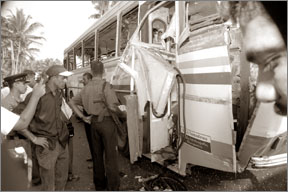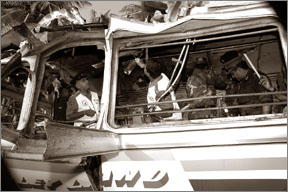|
observer |
|
|
|
|
|
OTHER LINKS |

|

|

|
Desperate Tigers target civiliansThe threat of a terror attack in the South has long been a concern. The State Intelligence Service (SIS) issued several intelligence warnings of the increasing danger of Tiger attacks on soft targets. The specifics of those warnings can not be discussed in detail due to their classified nature. However, it is suffice to say, the warnings highlighted the threat of attacks on the places of public congestion and several economic installations in particular. One such warning highlighted the danger of a commando style suicide attack on some of these installations of dual use - both economic and military - These were apart from increased threat on several VVIPs, upon which the security had been stepped up.
The understanding in the intelligence circles was that as the conventional military capacity of the Tigers was out flanked by the security forces, the LTTE would opt to attack soft targets. Military nerve centresThe beef up of security in the recent months, indeed, acted as an deterrent to the LTTE, mainly in its plans to attack economic and military nerve centres. This, further highlighted the increasing danger of soft targets, such as public transport and areas of public congestion. The question however was that other than routine roadside checking, there was little deterrent against such terror attacks. Earlier, as the threat of impending terror attack loomed large, a formation of a National Contingency Plan was acted upon in the face of a possible attack. Indeed, a team of security forces top brass, including Rear Admiral Sarath Weerasekara, Brigadier Milinda Peiris and several others were assigned to formulate a Contingency Plan in the aftermath of a terror attack, which was to cover, among other things, rescue missions, sending reinforcement, communication, emergency treatment and hospital facilities, etc. All these measures could only act as an deterrent, but still the Tigers could strike whenever the opportunity is available. Open societies make themselves vulnerable to intrusion due to the very freedom it allows to the citizenry. Terrorists and insurgents could utilise these very freedoms to plan and execute attacks against the very institutions of the open societies. Despite the recent curb on civil liberties by the anti-terror legislation, Sri Lanka deserves - still- to be called an open society. It is naive to expect the security forces to catch every LTTE sleeper and attacker and to raid every Tiger cell in the town. Very liberties they enjoy in the city of Colombo, a multi-cultural city itself provide greater room for terror cells to conduct their covert missions. Indeed, in recent times, there were notable success in counter-espionage activities on the terror cells of the LTTE in Colombo. Intelligence operatives succeeded busting some important networks of the LTTE cadres in the town. This along with the stepped up security in the city deterred the Tigers from attacking economic or military nerve centres. This forced the Tigers to go for civilian targets as the ultimate resort. It is in this context that successive terror attacks on the two passenger buses last week were not a cause for surprise. If there was any reason which discouraged the Tigers from attacking civilians, it was the international opinion. It is notable that even after taking on each and every civilian target during the ceasefire - the Kebithigollawa bombing, alleged killing of Muslims in Potuvil for instance, the Tigers routinely denied responsibility. Same protocol was followed last week as the LTTE military spokesman Rasaiah Ilanthirayan alias Marshal denied the LTTE involvement in the two blasts, describing the charge as "baseless allegations". But, interestingly enough, the bus attacks took place after the LTTE peace secretariat chief Pulithevan warned of "repercussions" against the air strikes in Mannar, of which the LTTE alleged 13 civilians were killed. In this sense, the two bus bombs were a means of retaliation. The threat of attacks on soft targets in the South has been part of LTTE's strategy through out the last twenty years of its insurgency. LTTE political commissar S. P. Thamilselvan earlier warned to bring the war to Colombo. Thamilselvan also insisted that the LTTE would use all possible means available in a future war with the Government - a not so subtle reference to the use of suicide cadres, the Black Tigers who are the ultimate weapon of the Tiger arsenal. In the face of increasingly assertive military posture by the government, the overall strategy of the LTTE, at present, is to break the political will of the government to carry on its military drive against the LTTE. This is a complete reversal from the Tiger strategy a year ago, when the Tigers launched a mini intifada in the Jaffna peninsula, using its sleepers and civilian militia and advanced it to an undeclared Eelam War IV. The LTTE strategy, at that point was to intimidate the newly elected Rajapaksa Administration in to submission. The strategy backfired and instead of forcing the government in to submission, it provoked the government which gave the green light to the security forces to adopt some tough counter-insurgency measures. The then emerging intifada in the Jaffna peninsula was subdued with these measures. The recent military operations in Sampur and Vakarai are an extension of the government's military drive to subdue the military capacity of the LTTE. LTTE strategyThe LTTE strategy is to force the government to abandon its military drive. This comes in the wake of heavy casualties inflicted on the LTTE by the revamped military. This deterred the LTTE from any kind of decisive military offensive in the North-East. In the absence of a military might to take on the security forces in the battle front, the Tigers opted to attack the targets in the South. Two successive bus bombs last week were part of the strategy to challenge the government will to carry on the military drive against the LTTE. Given the nature of the attack, one in rush hour office transport, it is obvious that launching such a attack requires little planning. It is as simple as some unassuming passenger getting off the bus, leaving his backpack, which happened to contain two kilos of explosives. Though it looks simple compared to complex manoeuvering of an attack on the VVIPs, bus bombs have a greater potency to evoke fear psychosis in the public. That is exactly the aim of the LTTE, which through, two successive blasts, has attempted to shutter the sense of perceived security in the Southern populace. The Tigers' intended political message of the attack is that the South is not secure as long as the LTTE is confronted militarily in the North-East. The strategy of the LTTE is to terrorise the general public and force them to influence the government to shift its approach towards the LTTE , from the present assertive military posture to a level of submission. The venue of the two attacks itself are both of symbolic as well as tactical value. Nittambuwa in the perimeters of Colombo and Godagama in the down South, which voted Mahinda Rajapaksa in en masse to the Presidency. However, according to some senior Police Officials, the two successive terror attacks on the public transport were also a pointer to the failure in risk assessment of the terror threat. Had the National Intelligence correctly figured the threat immediately after the first blast in Nittambuwa and had the public been alerted to exercise extra vigilance, the second attack could have been averted. The nearly twenty hour gap between the first attack and the second could have been enough to brace the public of the impending second attack. The response by the relevant authorities in this regard is too little and too late. Surveillance and securityThe Government later announced plans to install high tech surveillance and security equipment at the main Rail Stations. Bus Conductors were asked to check the baggage of passengers and civil vigilant forces were mobilised to help them. Public were asked to limit the size baggage. The stepped up security procedures were bound to cause further inconvenience to the passengers, who already have enough of their trauma the country's ramshackled bus and train service. However that seems to be the only deterrent to avoid an impending terror attack. STF operation in AmparaSpecial Task Force, the elite counter - insurgency wing of the Police last week overran two main LTTE camps and several satellite camps in the jungles of Kanchidudichcharu in Amparai with minimum resistance from the Tigers. The LTTE cadres retreated in to jungles as the Police commandos approached the Stanley Base, the main jungle camp of the LTTE and, later, the Janak Base, another main jungle camp. The Stanley Base is named after the local Tiger military leader, Stanley, who was believed to have fled the camp along with the rest of his fighters. The LTTE initially fired several rounds of mortars from the direction of the Janak Base as police commandos advanced towards the Stanley Base. Other than that the Tigers gave no notable resistance. Three police commandos were hit by anti-personnel mines. Four LTTE cadres were reported killed in the fight for the Janak Base. Two bodies of the LTTE were also found in an abandoned camp. Police Commandos also recovered one H.K.LMG gun, a sniper gun, two night vision goggle and a Generator, three motorbikes and two boats with the logo of the International NGO, Save the Children. The Save the Children Authorities responded that it believed the two boats were stolen in Nasivanthivu in Feb, 2006. The INGO further stated the AGA of the area was informed of the theft and an inquiry was lodged at the Valachchenai Police. There were also allegations that the INGO ZOA ran an hospital in the Stanley Base. ZOA had not officially responded to the allegations. The LTTE retreat in the face of advancing troops is a pointer to the growing disarray and lowering moral in the ranks of the LTTE. But, this is also a tactic to avoid heavier casualties at a time the LTTE manpower, as well as fire power - in the East is in decline. Several month ago, when the Police commandos in an earlier operation overran three jungle bases in Kanchikudichcharu, the Tigers followed the same tactic, abandoning the camps and regrouping later. Police commandoes have been mobilised in the jungle crossing points to prevent the LTTE cadres fleeing further down towards Maha Oya. The STF operations last week is, understandably, part of the greater plan of clearing the East of the LTTE. Though the Tigers would flee, rather than fight the security forces, the primary objective of the STF raid is to deny the Tigers an opportunity settle down and to regroup, thus lowering the organisational capacity of the Tigers. |













